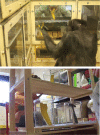Spontaneous categorization of tools based on observation in children and chimpanzees
- PMID: 31796823
- PMCID: PMC6890762
- DOI: 10.1038/s41598-019-54345-1
Spontaneous categorization of tools based on observation in children and chimpanzees
Abstract
The acquisition of the concept of 'tool' remains intriguing from both developmental and comparative perspectives. Our current model of tool use development in children is based on humans' supposedly unique ability to adopt a teleological stance: the understanding of a demonstrator's goal-based intentions when using a tool. It is however unclear how children and chimpanzees, our closest relatives, combine their knowledge of different objects whose function is to act on other parts of the environment, and assign them to a single category of 'tools'. Here, we used a function-based approach to address this question. We exposed 7 to 11-year-old children and adult chimpanzees to a Matching-to-Function (MTF) task to explore whether they would sort tools and non-tools separately after demonstration of their function by an experimenter. MTF is a variant of Matching-to-Sample where the sample and the target are from the same category/kind rather than identical. Around 40% of children paired objects according to their function in the MTF task, with only one child younger than 8 years doing so. Moreover, when verbally questioned, these children offered a function-based answer to explain their choices. One of six chimpanzees also successfully paired objects according to function. Children and at least one chimpanzee can thus spontaneously sort tools into functional categories based on observing a demonstrator. The success of a single chimpanzee in our task suggests that teleological reasoning might already have been present in our last common ancestor but also shows that human children more readily conceptualize tools in a spontaneous fashion.
Conflict of interest statement
The authors declare no competing interests.
Figures




References
-
- Shumaker, R. W., Walkup, K. R. & Beck, B. B. Animal Tool Behavior: The Use and Manufacture of Tools by Animals. (The Johns Hopkins University Press, 2011).
-
- Tomasello, M. & Call, J. Primate cognition. (Oxford University Press, 1997).

